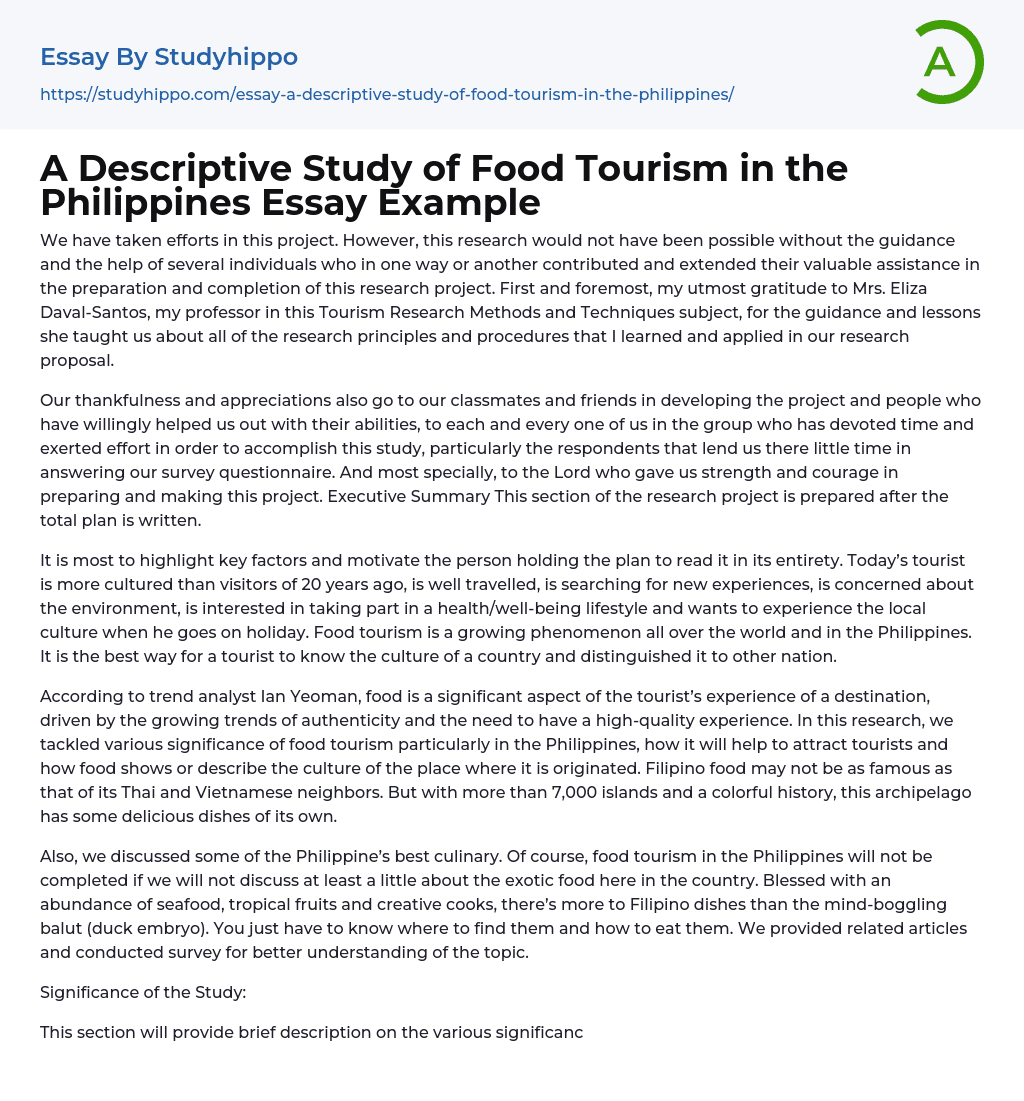

A Descriptive Study of Food Tourism in the Philippines Essay Example
In this project, we have made efforts with the guidance and help of several individuals who contributed to the preparation and completion of this research. I am deeply grateful to Mrs. Eliza Daval-Santos, my professor in the Tourism Research Methods and Techniques subject, for her guidance and lessons on research principles and procedures that I applied in our research proposal.
We are thankful to our classmates, friends, and everyone who helped us develop this project. We appreciate every member of our group who dedicated their time and effort to complete this study. We also thank the respondents for answering our survey questionnaire. And most importantly, we express gratitude to the Lord for giving us strength and courage throughout this project. The Executive Summary is a section that comes after the completion of the overall plan in a research
...project.
The text highlights key factors and urges readers to fully participate in the plan. Recent travelers have become more cultured than those from twenty years ago, having traveled extensively and now yearning for new experiences. Moreover, these travelers are also environmentally conscious, desiring to integrate health and well-being into their lifestyle, and eager to deeply engage with the local culture during their vacations. Food tourism is a rising trend worldwide, including in the Philippines. It serves as an optimal way for tourists to comprehend a country's culture and discern it from others.
According to trend analyst Ian Yeoman, food heavily influences a tourist's experience of a destination. This is due to the growing trends of authenticity and the desire for a high-quality experience. In this research, we focus on the importanc
of food tourism in the Philippines and how it can attract tourists. We also explore how food showcases the culture of its place of origin. While Filipino cuisine may not be as well-known as that of its Thai and Vietnamese neighbors, this archipelago boasts a rich culinary history and an array of delectable dishes thanks to its more than 7,000 islands.
Furthermore, we have delved into the Philippines' noteworthy culinary delights. It is crucial to highlight the country's distinct and unusual food choices as part of the overall food tourism experience. With an abundance of seafood, tropical fruits, and talented chefs, Filipino cuisine goes beyond the fascinating balut (duck embryo). To fully savor these offerings, it is essential to know where to find them and how best to enjoy them. To aid in understanding this subject better, we have provided relevant articles and conducted surveys.
The importance of the study is significant.
The significance of the study will be examined in three areas: Education, Economy, and Tourism. It will serve as a valuable resource for students interested in learning about the culinary options available in the country, particularly related to food tourism. The objective is to equip students with the necessary knowledge for internships in various sectors of the food industry, including Hotels, Resorts, and aviation, which cater predominantly to tourists.
The main objective of this study is to assist food establishment owners in comprehending tourists' preferences for food and strategies to take advantage of them. Moreover, it aims to improve the quality, creativity, and flavor of food to make it more globally competitive and economically advantageous. Furthermore, this research will provide
guidance for future researchers and contribute to the advancement of food tourism in the Philippines. Finally, it raises public awareness about the risks of contamination and poisoning from imported food.
The study has a few limitations. It specifically looks at restaurants and food establishments in the Philippines. Additionally, it only takes into account tourists who come to the Philippines Islands. It does not factor in the money spent by tourists on food and related activities. Furthermore, it is limited to students and educators in the Food and Tourism Industry. Lastly, the objective of the study is to provide a realistic generalization rather than test any theories.
Food tourism, also known as culinary tourism, is the act of experiencing the food of a country, region, or area. It is an essential part of the overall tourism experience and is defined by the World Food Travel Association as the pursuit and enjoyment of unique and memorable food and drink experiences, both near and far. Previously referred to as "culinary tourism," this industry is recognized by leading authority on food tourism, the World Food Travel Association.
The term "culinary" was discontinued in 2012 after research revealed it was misleading. Although the word technically encompasses all things food and drink, interviews with English-speakers showed that it is seen as elitist. In contrast, "food tourism" is a more inclusive phrase that encompasses food carts, street vendors, local pubs, wineries, and unique restaurants. The food tourism industry caters to a wide range of preferences.
- Food Safety essays
- Food Security essays
- Beverages essays
- Cuisines essays
- Dairy essays
- Desserts essays
- Fast Food essays
- Bread essays
- Meal essays
- Meat essays
- Organic Food essays
- Rice essays
- Sugar essays
- Taste essays
- Beef essays
- Coconut essays
- Crowd essays
- Dinner essays
- Juice essays
- Sainsbury essays
- Cooking essays
- Ginger essays
- Oreo essays
- Drink essays
- Beer essays
- Wine essays
- Coffee essays
- Tea essays
- Cake essays
- Hamburger essays
- Ice Cream essays
- Burger essays
- Pizza essays
- Fruit essays
- Lemon essays
- Food Waste essays
- Favorite Food essays
- Alcoholic essays
- Soft Drinks essays
- Cookie essays
- Starch essays
- Yeast essays
- Cola essays
- Pizza Hut essays
- snack foods essays
- chips essays
- Biscuit essays
- Brewing essays
- Brewery essays
- Barangay essays



